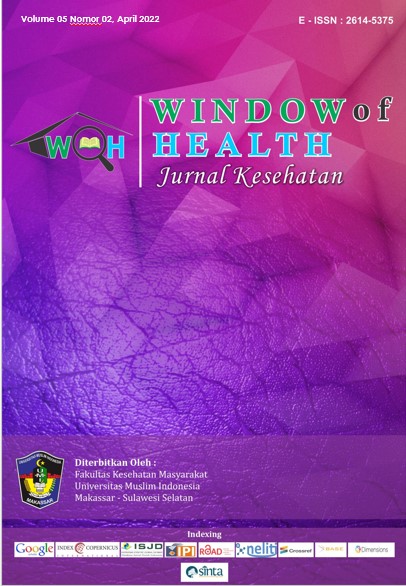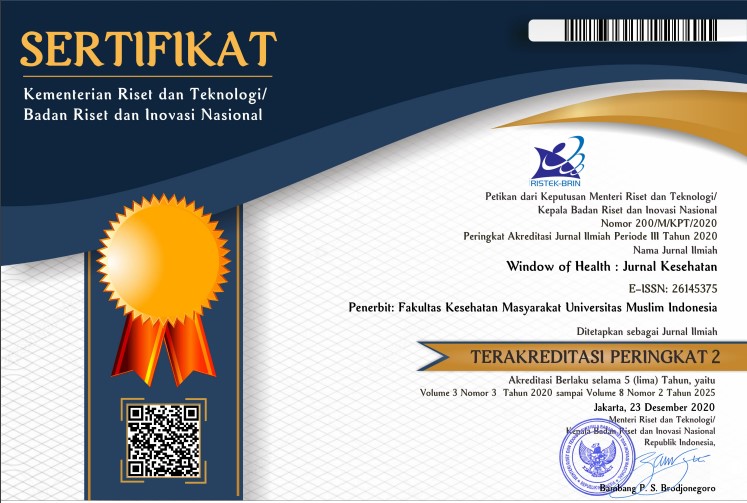Bioadsorben Campuran Kulit dan Tongkol Jagung untuk Menurunkan Kadar BOD Limbah Batik
Abstract
Liquid waste from batik industry often causes environmental problems, because there is a pollutant content of Biochemical Oxygen Demand (BOD). Corn cobs and husks contain high cellulose which has the potential to become activated carbon. This study aims to analyze the bioadsorbent mixture of cobs and corn husks in reducing BOD levels in batik wastewater. This type of research is pre-experimental, the research design is One Group Pretest Posttest Design. Variations in the mass of bioadsorbent mixture of corn cobs and husks with a ratio of (70:30), (60:40) and (50:50) contact time for 2.5 hours in 500 ml of batik liquid waste. Measurement of BOD levels was carried out after treatment. Data analysis using ANOVA test. The highest percentage of decrease in BOD levels after treatment was in the mass variation of 38 gr: 25 gr (60:40) 81.79% and the decrease value was 9243 mg/L. BOD levels before treatment using a mixture of cob and corn husk bioadsorbent were 11300 mg/L and after treatment it was 2057 mg/L which means that there is 1 pair of variations in the mass of the mixture of corn cobs and husks in reducing the average different BOD content in batik wastewater. Bioadsorbent mixture of cobs and corn husks can reduce BOD levels in batik wastewater.
References
Indrayani L. Pengolahan Limbah Cair Industri Batik Sebagai Salah Satu Percontohan Ipal Batik Di Yogyakarta. ECOTROPHIC J Ilmu Lingkung (Journal Environ Sci. 2018;12(2):173.
Rochma N, Titah HS. Penurunan BOD dan COD Limbah Cair Industri Batik Menggunakan Karbon Aktif Melalui Proses Adsorpsi secara Batch. J Tek ITS. 2017;6(2):2–7.
Peraturan Gubernur Jawa Timur No. 72 Tahun 2013. Tentang Baku Mutu Air Limbah. 2013;
Furqonita D. Seri IPA Biologi SMP Kelas VII. Jakarta: Yudhistira. 2006;
Wirosoedarmo R, Haji ATS, Hidayati EA. Pengaruh Konsentrasi Dan Waktu Kontak Pada Pengolahan Limbah Domestik Menggunakan Karbon Aktif Tongkol Jagung Untuk Menurunkan BOD dan COD The Influence Of Concentration and Contact Time in Domestic Sewage Treatment Using Activated Carbon the Cob of Corn. J Sumberd Alam dan Lingkung [Internet]. 2016;3(2):31–8. Available from: https://jsal.ub.ac.id/index.php/jsal/article/view/222
Wakid RN, Prasetyo RH, Mulyaningtyas A. Pengaruh Konsentrasi KOH dan Suhu terhadap Adsorpsi Cu pada Limbah Cair Batik dengan Adsorben Bonggol Jagung. 2020;14–5.
Ghafarunnisa D, Rauf A, Rukmana BTS. Pemanfaatan Batubara Menjadi Karbon Aktif dengan Proses Karbonisasi dan Aktivasi Menggunakan Reagen Asam Fosfat (H3PO4) dan Ammonium Bikarbonat (NH4HCO3). Proseding Semin Nas XII. 2017;1(1):36–41.
Ismail SNAS, Rahman WA, Rahim NAA, Masdar ND, Kamal ML. Adsorption of malachite green dye from aqueous solution using corn cob. AIP Conf Proc. 2018;2031(November 2018).
Mantong JO, Argo BD, Susilo B, Korespondensi P. Making Active Charcoal From Corn Cob Waste As Adsorbent At Liquid Waste Tofu. J Keteknikan Pertan Trop dan Biosist [Internet]. 2018;6(2):100–6. Available from: https://jkptb.ub.ac.id/
Lempang M. Pembuatan dan Kegunaan Karbon Aktif. Info Tek EBONI [Internet]. 2014;11(2):65–80. Available from: http://ejournal.forda-mof.org/ejournal-litbang/index.php/buleboni/article/view/5041/4463arang
Nurhasni N, Hendrawati H, Saniyyah N. Sekam Padi untuk Menyerap Ion Logam Tembaga dan Timbal dalam Air Limbah. J Kim Val. 2014;4(1).
Alfiany H, Bahri S, Nurakhirawati. Kajian penggunaan arang aktif tongkol jagung sebagai Adsorben logam Pb dengan beberapa aktivator asam. J Nat Sci. 2013;2(3):75–86.
Hartanto S, Ratnawati. Pembuatan Karbon Aktif dari Tempurung Kelapa Sawit dengan Metode Aktivasi Kimia. J Sains Mater Indones. 2010;12(1):12–6.
Laos EL. Pemanfaatan Kulit Singkong sebagai Bahan Baku Karbon Aktif. J Ilmu Pendidik Fis. 2016;1(1):32–6.
Irmanto S. Optimasi Penurunan Nilai BOD,COD dan TSS Limbah Cair Industri Tapioka Menggunakan Arang Aktif Dari Ampas Tebu. Molekul. 2010;5(1):22–32.








